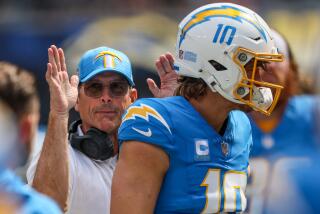Chrysler’s Red-Ink Lesson for Big Blue
- Share via
If IBM, which reported staggering losses Tuesday, or any other troubled company wants hope and encouragement, let them look to Chrysler.
The chronically struggling car company, which went from a government-financed rescue in 1980 to big profits by the mid-1980s and back again in recent years to near bankruptcy, is riding high once again.
Chrysler stock hit $38.50 a share Tuesday, and it is being hailed by automotive experts as “the best American car company today.”
That is some turnaround: Less than a year ago, Chrysler stock sold for $11.50, and banks were considering cutting off its credit.
How did Chrysler come back? Happily, it’s not a complicated story.
Faced with a crisis in 1989, Chrysler embarked on a massive cost-cutting program--aiming to slice $3 billion out of a total budget of $27 billion--but spared its hefty expenditures for new product development, as well as the $900 million a year it spends on research. It cut personnel from 92,000 to 69,000 and reorganized operations--often adapting competitors’ methods, such as Honda’s system of product development.
As a result, Chrysler this year is bringing out the most eye-catching new cars on the market--the Dodge Intrepid, Chrysler Concorde and Eagle Vision--and attracting buyers at an average price per car of $21,000, including options.
For Chrysler, the cars add to its success with minivans and the Jeep, and give the 68-year-old company an unprecedented direction for the future.
But if Chrysler teaches IBM and the rest of American business one lesson above all, it’s that victory is no more permanent than defeat.
Other lessons it teaches are that even severe financial problems can be corrected when a company gets back on track, so never underestimate the comeback potential of a once great outfit.
Also, it teaches that luck matters in business: General Motors and the Japanese car makers have been fumbling the ball, allowing Chrysler to gain.
Finally, Chrysler teaches that while a chief executive is important to a company’s success, replacing him when his time is up can be critical.
Chrysler, having come back from the grave, was on top of the world six years ago, with its stock at an all-time high. But its famed Chairman Lee Iacocca--as he later admitted--had taken his eye off the ball. Iacocca tried diversifying Chrysler into aerospace-defense, thinking that it offered shelter from Japanese competition. He eagerly sought a merger with a European car company, notably Fiat, believing that it offered Chrysler long-term security.
Meanwhile, Chrysler’s costs crept up, and earnings fell. By 1989, long-term debt and unfunded pension liabilities had almost doubled to $7 billion, and the company faced a recession that threatened to close its doors. That’s when Iacocca and other Chrysler managers got serious about cutting costs and developing new products.
Debt can be scary. Even as minivan and Jeep sales kept Chrysler afloat, and allowed it to invest $3.5 billion a year in product development, the credit agencies threatened to cut it off. Standard & Poor’s suggested in 1991 that only a massive selloff of plant and equipment would save the company.
But markets can turn quickly. Chrysler has just announced a sale of 40 million shares to raise roughly $1.5 billion for its pension fund and to reduce debt. Now the trend is running with Chrysler. It was profitable in 1992 and analysts expect earnings this year to come in at about $1 billion. The credit agencies have raised Chrysler’s rating, and the stock market applauds its every move.
Luck played a part. General Motors’ lack of success with new cars in recent years left an opening for Chrysler; Honda poured money into an unsuccessful sports car but neglected to update its Acura model, which is now losing sales to Chrysler’s new LH cars.
For the future, Chrysler will bring out a new small car in 1994 and then a new mid-sized line to compete with the Ford Taurus, Honda Accord and Toyota Camry.
“It will be a full-line manufacturer with an emphasis on niche areas--minivan and Jeep,” says Robert Eaton, the successor to Iacocca as Chrysler’s chairman.
Eaton, 52, comes from General Motors, where he helped lead its European recovery. Unlike Iacocca, who believed like many others that Chrysler needed a partner to survive, Eaton knows that the company is better off on its own if it can keep costs in line and bring out good products.
One analyst agrees: “Why partner with an inefficient producer? Fiat and Volkswagen need the kind of disciplining Chrysler has been through.”
Competitors won’t be standing still. “The next challenge for Chrysler is to become as good in quality and manufacturing as the Japanese. It is not there yet, although it is gaining,” says Doug Kevorkian, an associate of J. D. Power, the auto consulting firm.
In other words, you can’t sit on your laurels in today’s world. Chrysler learned that lesson. IBM has probably learned it too.






